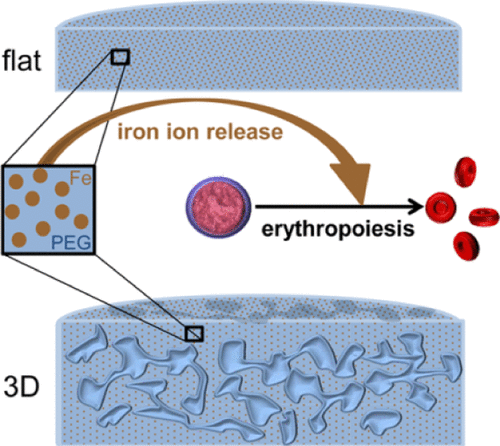当前位置:
X-MOL 学术
›
ACS Appl. Bio Mater.
›
论文详情
Our official English website, www.x-mol.net, welcomes your
feedback! (Note: you will need to create a separate account there.)
Iron Nanoparticle Composite Hydrogels for Studying Effects of Iron Ion Release on Red Blood Cell In Vitro Production
ACS Applied Bio Materials ( IF 4.6 ) Pub Date : 2020-07-01 , DOI: 10.1021/acsabm.0c00297 Katharina Brändle 1, 2 , Timna C Bergmann 2 , Annamarija Raic 1, 2 , Yaya Li 3 , Nina Million 3 , Christoph Rehbock 3 , Stephan Barcikowski 3 , Cornelia Lee-Thedieck 2
ACS Applied Bio Materials ( IF 4.6 ) Pub Date : 2020-07-01 , DOI: 10.1021/acsabm.0c00297 Katharina Brändle 1, 2 , Timna C Bergmann 2 , Annamarija Raic 1, 2 , Yaya Li 3 , Nina Million 3 , Christoph Rehbock 3 , Stephan Barcikowski 3 , Cornelia Lee-Thedieck 2
Affiliation

|
Growing numbers of complex surgical interventions increase the need for blood transfusions, which cannot be fulfilled by the number of donors. Therefore, the interest in producing erythrocytes from their precursors—the hematopoietic stem and progenitor cells (HSPCs)—in laboratories is rising. To enable this, in vitro systems are needed, which allow analysis of the effects of essential factors such as iron on erythroid development. For this purpose, iron ion-releasing systems based on poly(ethylene glycol) (PEG)–iron nanocomposites are developed to assess if gradual iron release improves iron bioavailability during in vitro erythroid differentiation. The nanocomposites are synthesized using surfactant-free pulsed laser ablation of iron directly in the PEG solution. The iron concentrations released from the material are sufficient to influence in vitro erythropoiesis. In this way, the production of erythroid cells cultured on flat PEG–iron nanocomposite hydrogel pads can be enhanced. In contrast, erythroid differentiation is not enhanced in the biomimetic macroporous 3D composite scaffolds, possibly because of local iron overload within the pores of the system. In conclusion, the developed iron nanoparticle-PEG composite hydrogel allows constant iron ion release and thus paves the way (i) to understand the role of iron during erythropoiesis and (ii) toward the development of biomaterials with a controlled iron release for directing erythropoiesis in culture.
中文翻译:

铁纳米粒子复合水凝胶用于研究铁离子释放对红细胞体外生产的影响
越来越多的复杂手术干预增加了对输血的需求,而献血者的数量无法满足这一需求。因此,在实验室中从其前体——造血干细胞和祖细胞 (HSPC)——生产红细胞的兴趣正在上升。为此,需要体外系统,以便分析铁等基本因素对红系发育的影响。为此,开发了基于聚(乙二醇)(PEG)-铁纳米复合材料的铁离子释放系统,以评估铁的逐渐释放是否能提高体外铁的生物利用度红系分化。纳米复合材料是直接在 PEG 溶液中使用无表面活性剂脉冲激光烧蚀铁来合成的。从材料中释放的铁浓度足以影响体外红细胞生成。通过这种方式,可以提高在扁平 PEG-铁纳米复合水凝胶垫上培养的红系细胞的产量。相比之下,仿生大孔 3D 复合支架中的红细胞分化并未增强,这可能是因为系统孔隙内的局部铁过载。总之,开发的铁纳米颗粒-PEG复合水凝胶允许持续释放铁离子,从而为(i)了解铁在红细胞生成过程中的作用和(ii)开发具有可控铁释放的生物材料以指导红细胞生成铺平了道路。文化。
更新日期:2020-08-17
中文翻译:

铁纳米粒子复合水凝胶用于研究铁离子释放对红细胞体外生产的影响
越来越多的复杂手术干预增加了对输血的需求,而献血者的数量无法满足这一需求。因此,在实验室中从其前体——造血干细胞和祖细胞 (HSPC)——生产红细胞的兴趣正在上升。为此,需要体外系统,以便分析铁等基本因素对红系发育的影响。为此,开发了基于聚(乙二醇)(PEG)-铁纳米复合材料的铁离子释放系统,以评估铁的逐渐释放是否能提高体外铁的生物利用度红系分化。纳米复合材料是直接在 PEG 溶液中使用无表面活性剂脉冲激光烧蚀铁来合成的。从材料中释放的铁浓度足以影响体外红细胞生成。通过这种方式,可以提高在扁平 PEG-铁纳米复合水凝胶垫上培养的红系细胞的产量。相比之下,仿生大孔 3D 复合支架中的红细胞分化并未增强,这可能是因为系统孔隙内的局部铁过载。总之,开发的铁纳米颗粒-PEG复合水凝胶允许持续释放铁离子,从而为(i)了解铁在红细胞生成过程中的作用和(ii)开发具有可控铁释放的生物材料以指导红细胞生成铺平了道路。文化。











































 京公网安备 11010802027423号
京公网安备 11010802027423号